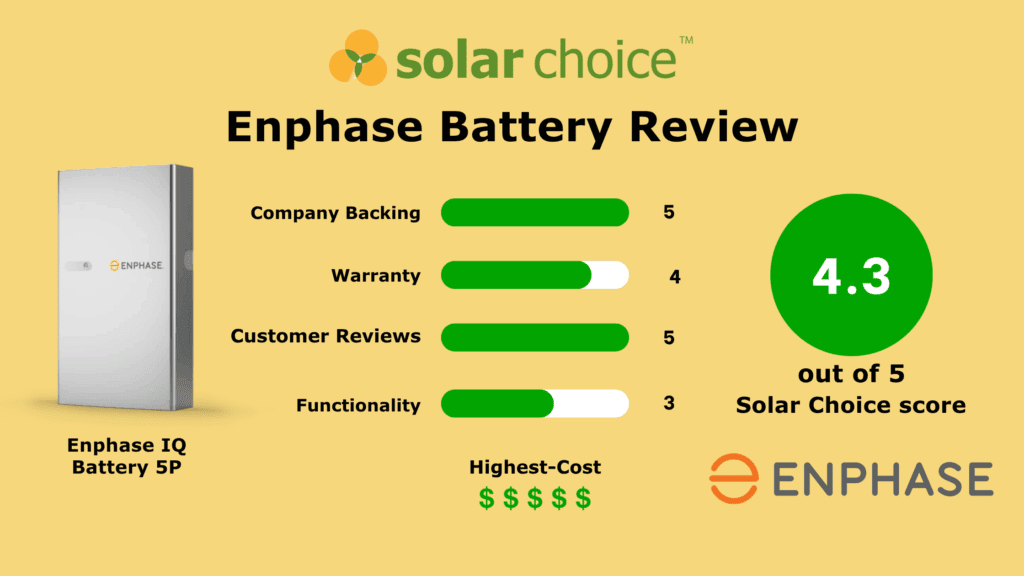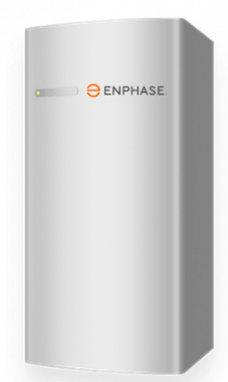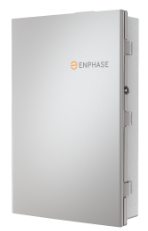At a Glance: Enphase Batteries Score 4.3 out of 5 – Excellent
Scoring is based on our solar battery scorecard which is consistently applied to each brand and battery available on the Australian market. This scoring reflects Enphase’s IQ Battery 5P.
$$$$$ Price: Based on data from Solar Choice’s network of solar installers, the average price for an installed Enphase battery is $1,465 per usable kWh. This places it in the as one of the most expensive options on the market.
- Company Backing and Trustworthiness (5 out of 5): Enphase has been active in Australia since 2012 with a substantial number of local support staff. With a globally strong brand and proven reliability in microinverter and battery technologies, it earns a full score for trust and backing.
- Warranty Offer (4 out of 5): Enphase offers a throughput warranty of 6 MWh per usable kWh (equivalent to 6,000 cycles), a 15-year product warranty, and a minimum capacity rating of 60% at the end of the warranty period. This robust offering ranks among the best available.
- Customer Reviews (5 out of 5): Enphase batteries have received strong customer feedback, with a verified average rating of 4.62 from 13 reviews on Solar Choice’s independent platform. This earns a perfect score under our review scoring system.
- Functionality (3 out of 5): Enphase batteries are AC-coupled, meaning they can be installed with virtually any existing solar system. They have UL 9540A fire safety certification and support modular battery balancing for expanding the capacity. However, they have a IP55 rating which is lower than some other leading batteries and are not stackable battery modules which adds to the cost of expanding.
Enphase – Company Overview
Enphase Battery Models and Options
Enphase IQ 5P Battery
IQ System Controller 3 INT
How Much Does an Enphase IQ Battery Cost?
Compare quotes from up to 7 installers in your area now.
Enphase’s Battery Warranty For Australian Customers
Enphase Batteries – Pros and Cons
Pros
- Big brand name, well known for premium solutions
- One of the longest and best warranty offers available for a residential battery
- Excellent feedback from verified customers
Cons
- One of the most expensive battery solutions
- Unable to be modularly expanded with additional DC battery modules which increases the cost for larger battery systems
Our Verdict On Enphase Batteries
If your looking for the best, the Enphase’s IQ Battery 5P stacks up favourably against most solutions on the market. Perhaps the most key point of different is their strong backing and reputation as a brand coupled with the demonstrated longevity of their batteries. This becomes evidence when you compare their warranty with any other battery.
Overall customers who have installed an Enphase battery appear to be very happy with its operation and performance. The only issue for customers will be whether they can fit this into their budget with the premium price tag.
Since 2008 our knowledge and sophisticated software has allowed over 300,000 Australian households and businesses to make a well-informed choice on their solar & battery installer.
- Running Cost of Air Conditioners – Explained - 7 October, 2025
- Air Conditioner Rebate South Australia: What You Need to Know - 19 September, 2025
- Air Conditioner Rebates in Queensland: What You Need to Know - 19 September, 2025
Reviews from Australians who have installed Enphase Batteries
I had 2 5P batteries installed. They have been working flawlessly and have already instantly kicked in exactly as described during a power outage. 10kwh has been perfect to get my household through peak pricing period in the evening and cover any gaps in demand and solar production. I usually have plenty of power of left when I go to bed which I pump into the car. They integrate smoothly into the Enlighten app and it is easy to see usage data and adjust settings.
Happy with Enphase, I have had the panels for 5 years and the battery fitted in well and uses the same App.
Review left 2 years after system installed
Several issues and outages in first 18 months
As having Enphase before I have found their product to be very reliable and great warranty backup.
We are pleased with the information supplied about the Enphase IQ battery 5P. Our research has indicated that this iron phosphate battery is very low risk and safe when it comes to battery fires.
Review left 7 years after system installed
Batteries (2 No) installed April 2021 and supplied and installed by RK Solar
Enphase IQ Battery 5P
Yes
Review left 8 years after system installed









Robert Brown, first its more than 10YR lifespan for the Enphase ACB. Second, you’re going by utility rates now with no guarantee they will remain fixed over the next decade or so. Another hidden attribute of the AC Battery is that it is a decentralized power topology and not centralized with a single point of failure. That true fault tolerance and reliability to the customer has to be worth more than a centralized residential storage solution.
I have never read so much b*** in one place. Your article so mislead, it is really only a test for the stupid. From your own data on savings which is questionable. The battery saves $400 per year, costs $7000 upfront and last 10 years. You can easily work out your total savings over the 10 year lifespan is $4000 yet your total outlay is $7000. Total savings negative $3000! And I did not even take into consideration value of money over time as the $7000 is an upfront payment where the $4000 is over a 10 year period.
Hi Robert,
Thanks for your comment.
We’ve tried to ensure that our analysis is fairly straightforward, and we’ve clearly displayed the ‘battery only’ payback periods in each of the tables. If we were misrepresenting – or not showing – these numbers, you might have a case for calling it b***s*** but that’s clearly not what we’re doing here. This is a level-headed analysis of a product that a lot of people will come across as they do their research.
As a comparison & advice service, we don’t sell any products ourselves, and our site (and quote comparisons) are devoted to helping people make an informed decision about going solar and/or getting batteries. Our battery calculator (linked to multiple times in this article) will help anyone work out ballpark figures on their own – without any ‘rose coloured’ results.
Residential battery systems are gaining a lot of steam in Australia. You’ll note that a large portion of this article is devoted to explaining how batteries work generally, with a specific focus on Enphase’s AC Battery. It’s our hope that anyone who reads it comes away feeling that they’re in a better position to making a decision about whether to get batteries for their home – even if that decision is to hold off on purchasing them for now.